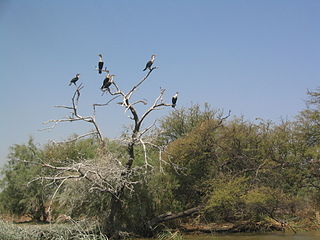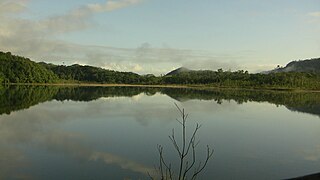
The aquatic warbler is an Old World warbler in the genus Acrocephalus. It breeds in temperate eastern Europe and western Asia, with an estimated population of 11,000-15,000 pairs. It is migratory, wintering in west Africa. After many years of uncertainty, the wintering grounds of much of the European population were finally discovered in Djoudj National Bird Sanctuary, Senegal, with between 5,000 and 10,000 birds present at this single site. Its south-westerly migration route means that it is regular on passage as far west as Great Britain and Ireland.
UNESCO Biosphere Reserves are environment-protected scientific-research institutions of international status that are created with the intent for conservation in a natural state the most typical natural complexes of biosphere, conducting background ecological monitoring, studying of the surrounding natural environment, its changes under the activity of anthropogenic factors.

Keoladeo National Park or Keoladeo Ghana National Park is a famous avifauna sanctuary in Bharatpur, Rajasthan, India, that hosts thousands of birds, especially during the winter season. Over 350 species of birds are known to be resident. It is also a major tourist centre with scores of ornithologists arriving here in the hibernal season. It was declared a protected sanctuary in 1971 and established as a national park on 10 March 1982. It is also a World Heritage Site.

Obedska bara is a large swamp-forest area and natural reserve stretching along the Sava River in Serbia, in Southern Syrmia (Srem/Szerémség), some 40 km west of Belgrade.

Lake Žuvintas is a shallow lake in Alytus district, central Lithuania. Area of Žuvintas Lake is 965 ha. It is the shallowest lake in Lithuania with the greatest depth 3 m and average only 0.6 m. It is a paradise for water birds, but also faces danger of becoming a swamp.
India is home to a large variety of wildlife. It is a biodiversity hotspot with its various ecosystems ranging from the Himalayas in the north to the evergreen rain forests in the south, the sands of the west to the marshy mangroves of the east. India lies within the Indomalayan realm and is the home to about 7.6% of mammal, 14.7% of amphibian, 6% of bird, 6.2% of reptilian, and 6.0% of flowering plant species. India's forest lands nurture about 500 species of mammals and more than 2000 bird species.

Gornje Podunavlje Special Nature Reserve is a large protected area of wetland in the northwest of Serbia, on the Danube's left bank. It comprises two large marshes, Monoštorski Rit and Apatinski Rit and vast forests, meadows, ponds, swamps and the Danube's meanders, including 66 km (41 mi) of the Danube course. It is a part of the trans-boundary biosphere reserve "Mura-Drava-Danube", a five country project, dubbed the "Amazon of Europe".

Cardiff Bay Wetlands Reserve is located in Cardiff Bay in the city of Cardiff. It covers an area of approximately 8 hectares. The area was officially opened as a wildlife reserve on 25 July 2002 in what was previously an area of Site of Special Scientific Interest (SSSI) up until the opening of the Cardiff Bay Barrage in April 2001. The area had previously been salt marsh, but the Barrage created 200 hectares of freshwater lake, and from this the reserve was developed.

Protected areas of Poland include the following categories, as defined by the Act on Protection of Nature of 16 April 2004, by the Polish Parliament:

The West Coast National Park lies 88 km (55 mi) north of Cape Town in the Western Cape province of South Africa. The park is found inside of the Cape West Coast Biosphere Reserve, part of the UNESCO Man and the Biosphere Programme. It is bordered by the Atlantic Ocean on the west and the R27 coastal road, and runs from the town of Yzerfontein in the south, up to the Langebaan Lagoon. The park is particularly well known for its bird life and for the spring flowers which occur in the months from August to September, especially in the Postberg flower reserve section of the park. The park, with the islands in Saldanha Bay, has been identified by BirdLife International as an Important Bird Area. The park was proclaimed in 1985, and is 36,259.8 hectares (140.000 sq mi) in size.

The Djoudj National Bird Sanctuary lies on the southeast bank of the Senegal River in Senegal, in northern Biffeche, north east of St-Louis.
Biosphere reserves are established according to the UNESCO's Man and the Biosphere Programme (MAB) to promote sustainable development for conservation of biological and cultural diversity. As of 2016, the Lal Suhanra Biosphere Reserve and Ziarat Juniper Forest are the only two biosphere reserve in Pakistan, which were approved by UNESCO in 1977 and 2013 respectively. A number of initiatives and projects have been undertaken to promote and develop other biosphere reserves in Pakistan but due to weak implementation this has not yet been materialized. In July 2012, Pakistan Museum of Natural History and Beijing Museum of Natural History signed a MoU to work on trans-boundary biodiversity and to improve MAB related activities in the Karakoram, Himalaya, and Hindukush regions.

The wildlife of Ukraine consists of its diverse fauna, flora and funga. The reported fauna consists of 45,000 species when including the areas of the Black Sea and the Sea of Azov. The country's protected environments consist of 33 Ramsar sites covering a total area of 7,446.51 square kilometres (2,875.11 sq mi). Biosphere nature reserves and three national parks are all part of the GEF projects portfolio of conservation of biodiversity in the Danube Delta. Their vegetation pattern is Mixed Forest area, Forest-Steppe area, Steppe area, Ukrainian Carpathian Mountains and Crimean Mountains. Some of the protected areas that were reserves or parks are subsumed under the biosphere reserves.

The Alakol Biosphere Reserve is a UNESCO Biosphere Reserve located in Kazakhstan, within the desert zone of Eurasia in the central part of the Alakol inter-mountain depression. The 193,089 hectares (745.52 sq mi) reserve lies on the Central Asian–Indian bird migration route. The wetlands of the reserve are of global significance as a habitat and as a nesting site for water birds.

The Red River Delta Biosphere Reserve is a UNESCO biosphere reserve in the coastal region of northern Vietnam. Mangroves and intertidal habitats of the Red River Delta form wetlands of high biodiversity especially in the Xuan Thuy and Tien Hai districts. These wetlands are of global importance as migratory sites for several bird species.

The Central Mexican wetlands is a flooded grasslands and savannas ecoregion in central Mexico.

Nahá–Metzabok Biosphere Reserve is a biosphere reserve in southeastern Mexico. It is located in the state of Chiapas, on the northeastern flank of the Chiapas Highlands. The reserve protects montane rain forests, pine and oak forests, and natural lakes.

The West Polesie Transboundary Biosphere Reserve is a transboundary nature reserve located in Poland, Ukraine, and Belarus. It is designated as an area of global importance under UNESCO's World Network of Biosphere Reserves under their Programme on Man and the Biosphere.

















